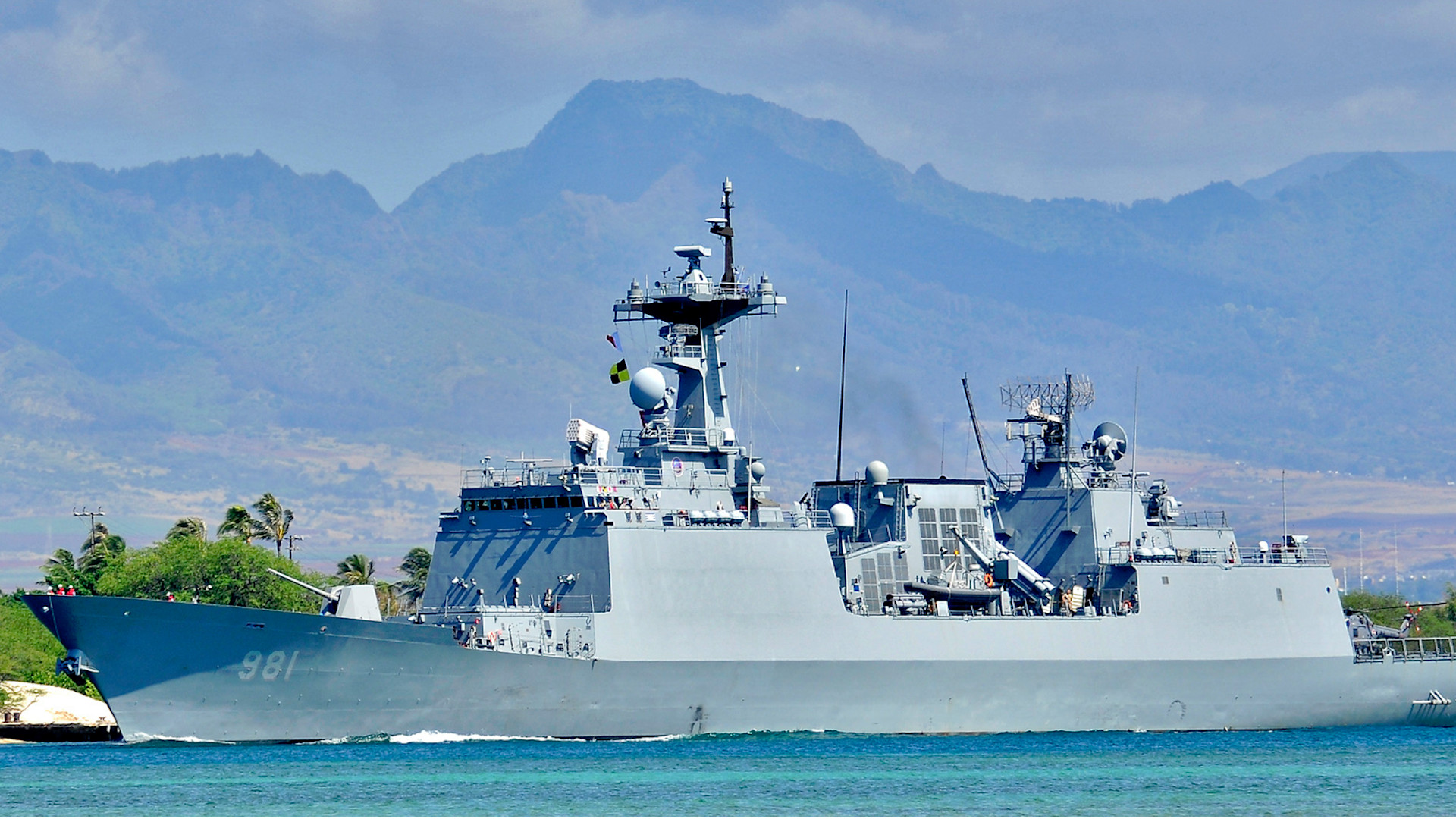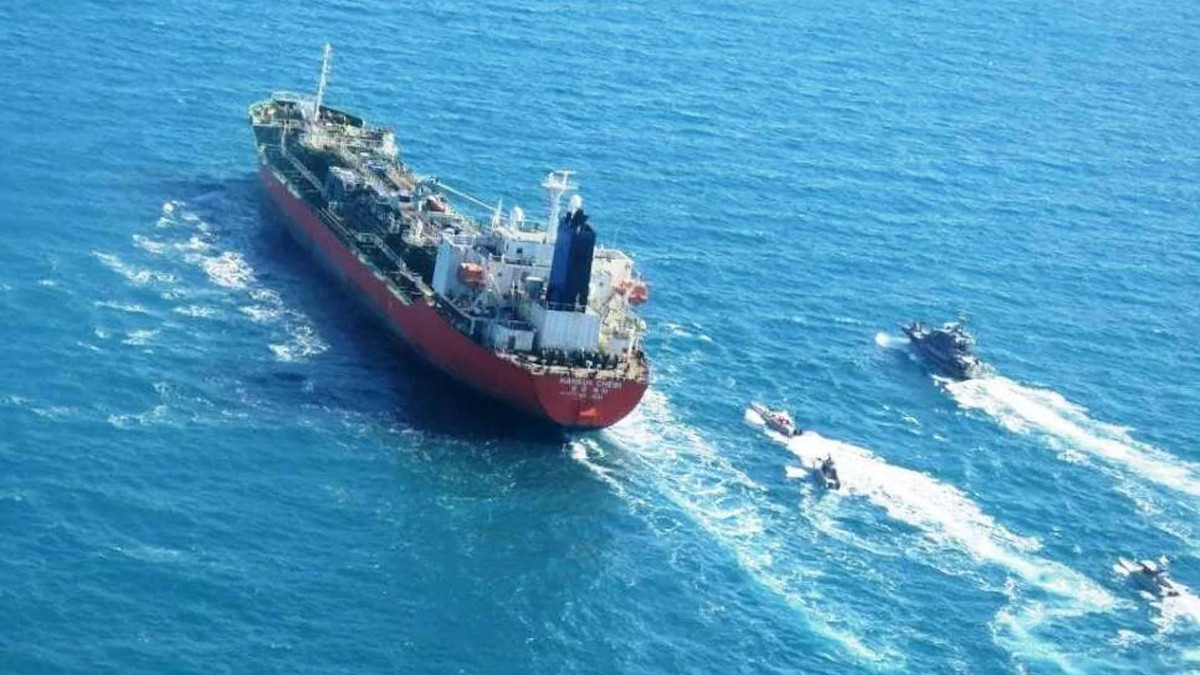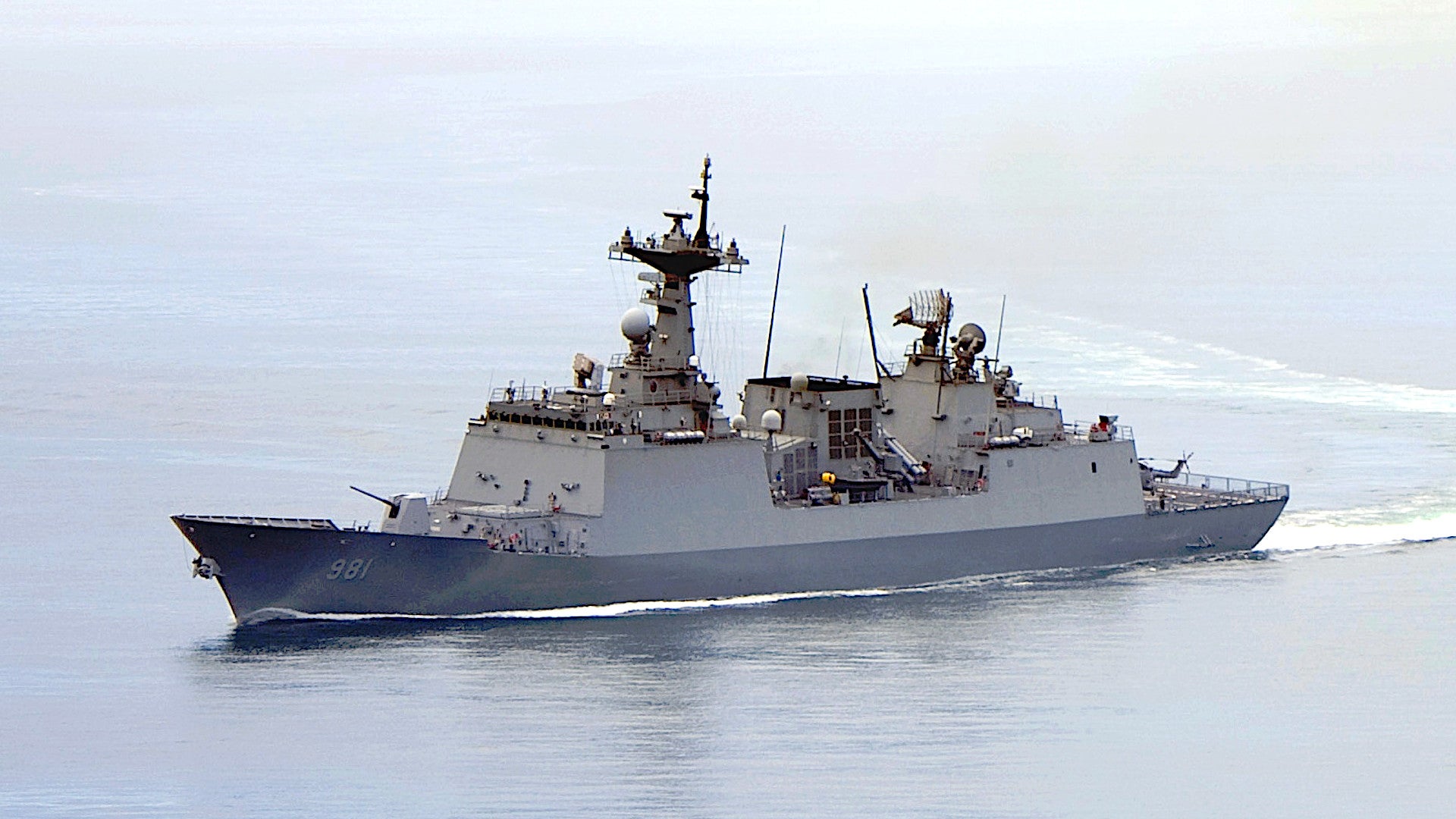The South Korean Navy’s Chungmugong Yi Sun Sin class destroyer Choi Young has arrived near the strategic Strait of Hormuz, a day after Iran’s Islamic Revolutionary Guard Corps seized a South Korean-flagged commercial tanker, the Hankuk Chemi. You can read more about that incident in The War Zone‘s initial reporting on this situation. Officials in Seoul say that this warship will now be available to help other South Korean merchant vessels transit the area safely, but insist that they will settle the matter of the detained tanker with authorities in Tehran diplomatically.
The South Korean Ministry of Defense confirmed that the Choi Young, also sometimes written Choe Yeong, had arrived in the area on Jan. 5, 2021. The destroyer presently forms the core of the country’s Cheonghae military unit, which is made up of rotational forces deployed primarily to support counter-piracy operations in the Middle East and off the coast of the Horn of Africa. This unit also includes a specialized element focused on visit, board, search, and seizure (VBSS) operations.

“The Cheonghae Unit arrived in waters near the Hormuz Strait earlier in the day,” South Korean Defense Ministry spokesperson Boo Seung Chan said during a press briefing. “It is carrying out missions to ensure the safety of our nationals.”
The Choi Young, which has a standard displacement of around 4,400 tons and can displace up to 5,520 tons with a full combat load, is a modern multi-purpose warship. Also known as the KDX II class, the first of these ships entered service in 2003.
The primary armament on these ships are Mk 41 Vertical Launch System (VLS) arrays, with each of the destroyers having a total of 64 cells. These can be loaded with a mixture of U.S.-made Standard Missile 2 Block IIIA surface-to-air missiles or South Korean-designed Hyunmoo-3 land-attack cruise missiles, as well as the Korean Anti-Submarine Rocket (K-ASROC), also known as the Red Shark, an anti-submarine weapon that has a homing torpedo as its warhead. We don’t know what the Choi Young‘s exact loadout is on this deployment.

The ships also have two four-tube Harpoon anti-ship missile launchers and a five-inch main gun, as well as RIM-116 Rolling Airframe Missile (RAM) launcher and a 30mm Goalkeeper weapon system for close-in defense. The destroyers have hangars and helipads to support up to two Lynx light helicopters, as well.
All told, the Choi Young presents a very capable deterrent against any potential attempts by the Iranians to seize any additional South Korean-flagged merchant vessels that pass through the Strait of Hormuz, which links the Persian Gulf and the Gulf of Oman. Approximately 20 percent of all of the world’s oil exports pass through this narrow waterway and South Korea is one of the globe’s top 10 oil importers. An average of six South Korean-flagged ships transit this strait, in one direction or the other, every day, according to South Korean news outlet Yonhap.
Of course, it’s important to remember that the South Korean destroyer is only one ship and cannot be everywhere at once, so there remains a potential risk of further seizures. The South Korean government is not part of the U.S.-led International Maritime Security Construct, which was formed in 2019 to monitor for and otherwise deter Iranian aggression in the region, including against commercial shipping, but has said it actively coordinates with that entity.
In the meantime, South Korea says it is working through diplomatic channels to free the Hankuk Chemi and its crew of 20, which includes a mixture of South Korean, Myanmarese, Indonesian, and Vietnamese nationals.

“The issue should be resolved through diplomacy,” a South Korean official said, according to Yonhap. “The [Cheonghae] unit is focused on the safety of our people who use the waterway after the seizure incident.”
“We have been trying to figure out what happened through the Iranian Embassy in South Korea and the South Korean Embassy in Iran and continuing to make efforts to address this situation,” South Korean Foreign Minister Kang Kyung Wha also told reporters.
Iran claims that the ship and its crew were detained for violating environmental protocols, something Hankuk Chemi, which the vessel’s operator, Taikun Shipping, has denied. Initial reports had identified that operator as DM Shipping, but that company is actually the owner of the tanker.
“If it really was marine pollution, as they say, the coast guard was supposed to approach the ship first,” Lee Chun Hee, Management Director at Taikun, told The Washington Post. “But instead, armed soldiers approached the crew and said they needed to be investigated.”

Iranian authorities have all but admitted that the actual reason for impounding the ship has to do with a spat between Tehran and Seoul over $7 billion in frozen Iranian assets in South Korea due to sanctions. South Korea had also been a major importer of Iranian oil until May 2020, when it stopped those purchases in the face of U.S. government pressure.
“We’ve become used to such allegations,” Iranian government spokesperson Ali Rabiei said in response to a question during a press conference about whether seizing the Hankuk Chemi amounted to hostage-taking. “If there is any hostage-taking, it is Korea’s government that is holding $7 billion, which belongs to us, hostage on baseless grounds.”
South Korea’s Vice Foreign Minister had already been scheduled to travel to Iran this coming weekend, in part to discuss this matter, and officials in Seoul say that this trip will proceed as planned. The South Korean government is also now preparing to send a “working level” diplomatic team to that country in response to the Hankuk Chemi incident. South Korea, as well as the United States, have otherwise called for the immediate release of the tanker and its crew.
This hardly the first time Iran has seized a commercial ship, or been tied to attacks on them, in an attempt to apply pressure on the international stage. In 2019, the Islamic Revolutionary Guard Corps (IRGC) took control of the British-flagged tanker Stena Impero in retaliation for U.K. authorities in Gibraltar impounding an Iranian tanker, then known as the Grace 1. On the same day that Stena Impero was seized, they also briefly detained another British-owned ship, flagged in Liberia, later claiming they had simply boarded it to make various regulations, including environmental protocols, clear to the crew. Iran released the Stena Impero in September of that year, the month after Grace 1
was allowed to leave Gibraltar.

A Japanese-owned tanker was also one of two that were victims of attacks linked to Tehran in the Gulf of Oman in June 2019. That incident came as then-Japanese Prime Minister Shinzo Abe was in Iran to meet with the country’s Supreme Leader, Ayatollah Ali Khamenei.
The IRGC’s seizure of the Hankuk Chemi also comes amid a spike in tensions between Iran, as well as its regional proxies, and the United States, over a host of issues, including Tehran’s recent decision to begin enriching uranium to 20 percent purity, putting it closer to producing weapons-grade nuclear material should it decide to pursue such a development. This follows the assassination of top Iranian nuclear scientist Mohsen Fakhrizadeh, which Iranian authorities blame on Israel, and is in clear violation of a controversial international agreement over the country’s nuclear program. President Donald Trump announced the U.S. government was pulling out of that deal, formally known as the Joint Comprehensive Plan of Action, in 2018.
Concerns about a potential attack from Iranian forces, or militant groups that Tehran actively supports in the Middle East, especially in Iraq, had been steadily building in the lead up to the first anniversary of the U.S. military drone strike that killed senior IRGC General Qassem Soleimani on Jan. 3, 2020. Iranian officials have issued various threats and calls for revenge, including against U.S. President Donald Trump directly.
This reportedly prompted Trump to order the Pentagon to reverse course on plans to bring the supercarrier USS Nimitz home and instead have it sail back to the Middle East. That decision followed weeks of other signaling meant to deter the regime in Tehran, including multiple long-range B-52 bomber sorties to the region, as well as the rare public transit of the Ohio class guided-missile submarine USS Georgia
through the Strait of Hormuz into the Persian Gulf in December.

There have been no apparent attacks, so far, on U.S. interests in the region that have been specifically linked to the anniversary of Soleimani’s death. However, the ongoing situation regarding Hankuk Chemi, which has now prompted the appearance of a South Korean warship near the already often tense Strait of Hormuz, shows that the region is as volatile as ever and no nation’s shipping is really safe.
Contact the author: joe@thedrive.com
